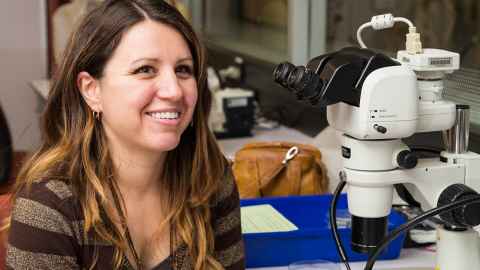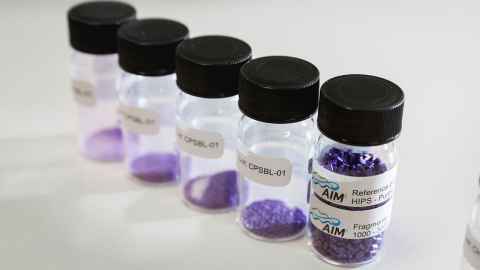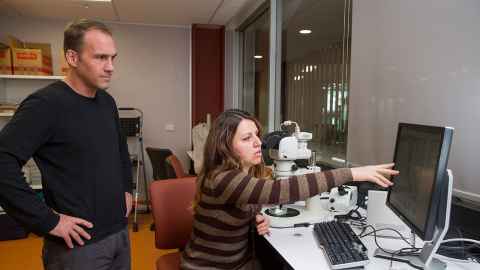Plastic plague for our waterways
21 April 2020
Researchers find microplastic pollution in Auckland waterways that rivals that found in the Rhine.



Nadezhda Dikareva is an expert in something she wishes she didn’t have to be. Arguably she is the most knowledgeable person in the country on the quantity and types of microplastics lurking in Auckland’s streams and waterways.
Nadezhda, who goes by Nadia, was born in Russia and traces of her mother tongue remain as she speaks about her research project at the School of Environment at the University of Auckland. In late 2016 she spent a fortnight in waders collecting water and sediment samples from 18 streams from Slippery Creek in Papakura to a stream in Shakespear Regional Park in the north.
That was the easy part. She then spent a further four months sifting plastic particles from organic matter for further analysis under a microscope and then a spectrometer to pin down their composition. The result was a paper Microplastic pollution in streams spanning an urbanization gradient, published in the journal Environmental Pollution.
The good news. “We didn’t find very many microbeads,” she says. The purposefully designed microbeads in facial scrubs and cleansers were banned here in June 2018, following a consultation that saw more than 16,000 submissions in support of the ban and none opposed. While the ban makes sense, microbeads are not the major source of micro-plastic pollution in Auckland’s waterways.
Instead her hunt revealed mostly fragments of plastic, almost 80 percent, followed by fibres and films. The mesh of her collection net was fine enough to capture any particles in water bigger than 15 microns (1 micron is one millionth of a metre). In the lab the micro-plastics ranged from 63 microns to 5000 microns.
Identity confirmed
In all Nadia isolated 3309 particles via microscope and then confirmed their identity through spectroscopic analysis. The films were mostly acrylate polymers used in paints and coating materials, the fragments, polyethylene and polyvinyl chloride (PVC), common plastics found in everything from construction materials to cars.
The bad news is that the concentration of micro-plastics in Auckland streams matches that found in much more densely populated northern hemisphere cities. On average Auckland’s waterways have between 17 and 303 particles of micro-plastic per cubic metre of water and between 9-90 items in each kilogram of sediment.

“I was surprised. The streams here are small and New Zealand is supposed to be clean, but the levels were the same as the Danube and the Rhine.”
This is the level of microplastic pollution found in the Danube and Chicago rivers, waterways running through heavily populated cities. The level of micro-plastic pollution in Auckland’s waterways was much less than that found in the tributaries of Lake Ontario, the Thames and the Beijiang, a river suppling water to the cities of Guangdong, Southern China.
But it is notable that in the Beijiang, a river running through a region with 104 million people, the sediment averages about 312 micro plastic items per kilogram, only a factor of three worse than Auckland, with 1.65m people. The Auckland region findings are comparable with Chicago, a city with twice the population.
Numbers, Nadia cautions, only tell part of the story. The grand rivers sampled overseas are complex, flow faster and deposit sediment differently. “But, yes, I was surprised. The streams here are small and New Zealand is supposed to be clean, but the levels were the same as the Danube and the Rhine.”
Unpalatable thought
It’s an unpalatable thought. Despite our small population and distance from industrial centres New Zealand is not doing any better in the micro-plastic pollution stakes. Nadia says, “We are creating a similar mess as in every other city. We may not be as careful towards the environment as we think we are.”
Nadia sampled streams throughout an urbanisation gradient. Shakespear stream in the north and Cascades stream in the west, both in regional parks have a population density of zero. Meola and Cox’s Creek in the inner city run through suburbs that have more than 4000 people per square kilometer. The assumption is that more people means more plastic pollution. Nadia’s research does not show this at all. There wasn’t a significant correlation.
Her paper suggests that microplastic pollution in streams we might consider pristine might be due to ‘localised’ impacts, the streams in regional parks might be experiencing run-off from rubbish left by people using the parks. Another factor might be plastic fibres carried in the atmosphere and settling on regional parks.
Microplastic pollution research is a burgeoning field. Footage of remote tropical seas carpeted with plastic bags sparks understandable public concern but even more consequential questions remain unanswered about the plastics in our waters that we cannot see.

Nadia’s research is supervised by Associate Professor Kevin Simon, an environmental scientist at the University of Auckland.
He tells a story about being called by a regional council in the South Island. A roading contractor was proposing to spray a plastic coating to stabilize a bank above a road. “They rang me as they wanted to know if this would be a problem for the environment. I could see how it might be but I couldn’t really give them an answer. That’s tough. As a scientist you want evidence to speak to.”
The assumption is that micro-plastics are likely to have a wider impact on the environment because they are dispersed so widely and enter the eco-system at the beginning of the food chain. Nadia’s research was prompted by conversations with friends working in a Russian research institute in the Arctic. They were surprised to find micro-plastics in the chill seas in some of the remotest parts of the planet.
Though plastics have been around for more than a century, the scientific jury is still out on what impact they might have on organisms and river and ocean eco-systems.
Kevin says, “There’s now more work focused on the effects of plastics on organisms. Some studies say nothing happens. Others point to some effects. Certain types of plastics will be a problem in some situations.”
Research radar
Microplastics in waterways and seas came onto the research radar a decade or so ago and concerted research has only been underway for five or six years. For the moment, though moment Simon says,” We aren’t far enough along to know.”
Science cannot tell us which plastics are a problem. “We’re banning microbeads and shopping bags, and that is a good thing but they may not be the most important problem. The trick is knowing which plastics are a problem so we can be smart about how to use and manage plastics.
“We do run the risk of getting rid of the plastic shopping bags and the micro-beads and thinking job done. Meanwhile we completely miss the bigger problem.”
The sorry tale of plastic pollution
Invented in the late 19th century, plastic production took off from 1950. The largest market for plastics today is as packaging materials. Plastic packaging accounts for nearly half of all plastic waste globally. Most of it never gets recycled or incinerated.
- 300,000 tonnes: plastic resin imported into New Zealand for manufacturing in 2017
- 41,500 tonnes: plastic waste exported from New Zealand in 2017
- 9.2 billion tonnes: plastic manufactured globally up to 2017
- 6.9 billion tonnes: plastic ending up as waste
- 8.8 million tonnes: plastic entering the oceans annually
- 128 billion: number of bottles produced by the Coca-Cola company each year
- 15 to 51 trillion: estimated number of microplastic particles in oceans (2014)
- 325: microplastic particles per litre of bottled water, mostly less than 100 microns.
Source: National Geographic; Royal Society Te Aparangi
Nadia will continue to sample near shore waters for microplastics to help understand how they enter the ocean. For her the question is will the microplastics she found in the waterways match those in the near shore environment.
A further task will be to take core samples from the near shore seabed. Analysis of the cores should allow the researchers to look back in time to the origins of plastic in the environment in the 1950s through to the present day.
Kevin says, “If we know anything it is that old plastic doesn’t go away. It degrades very slowly so part of this work will be about finding how it declines and figuring out how to measure that.”
Without evidence scientists are loathe to jump to solutions. But if pressed Kevin would say that the complex problems microplastics create will need a range of responses from preventing plastic litter from entering waterways to clean up campaigns and most importantly avoidance of certain plastics and compounds if they are found to be a hazard.
Story by Gilbert Wong
Researcher portrait by Billy Wong
The Challenge is a continuing series from the University of Auckland about
how our researchers are helping to tackle some of the world's biggest challenges.
To republish this article please contact: gilbert.wong@auckland.ac.nz